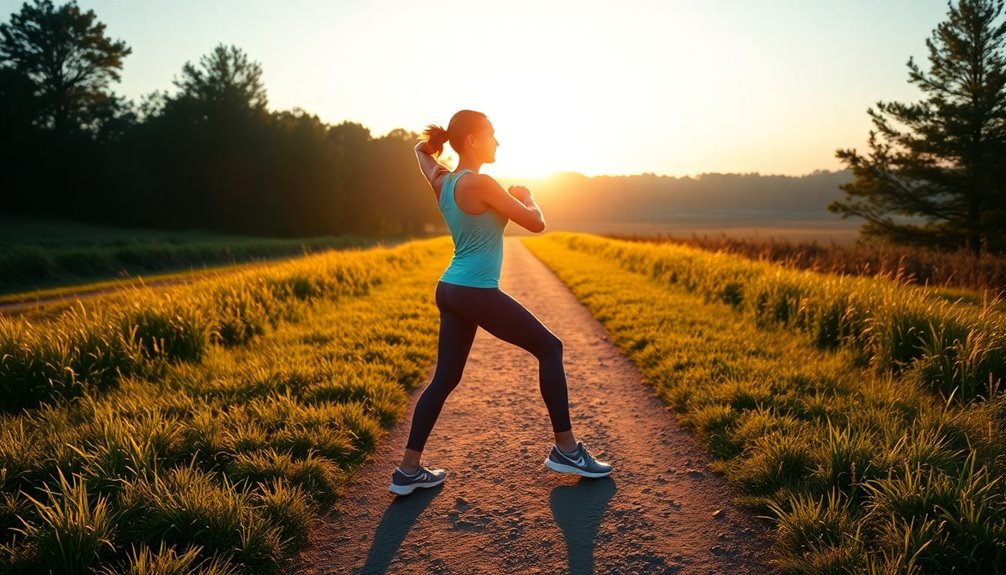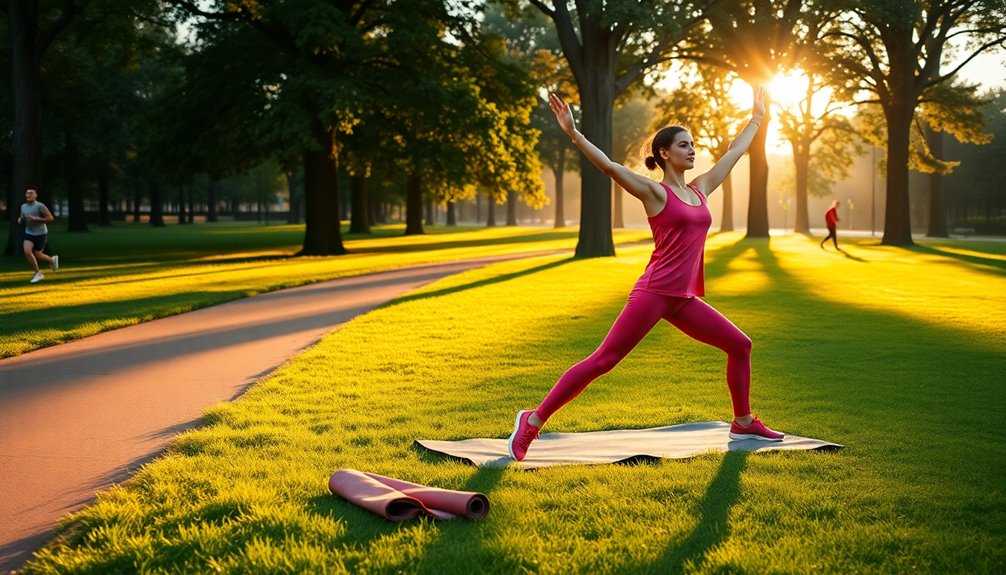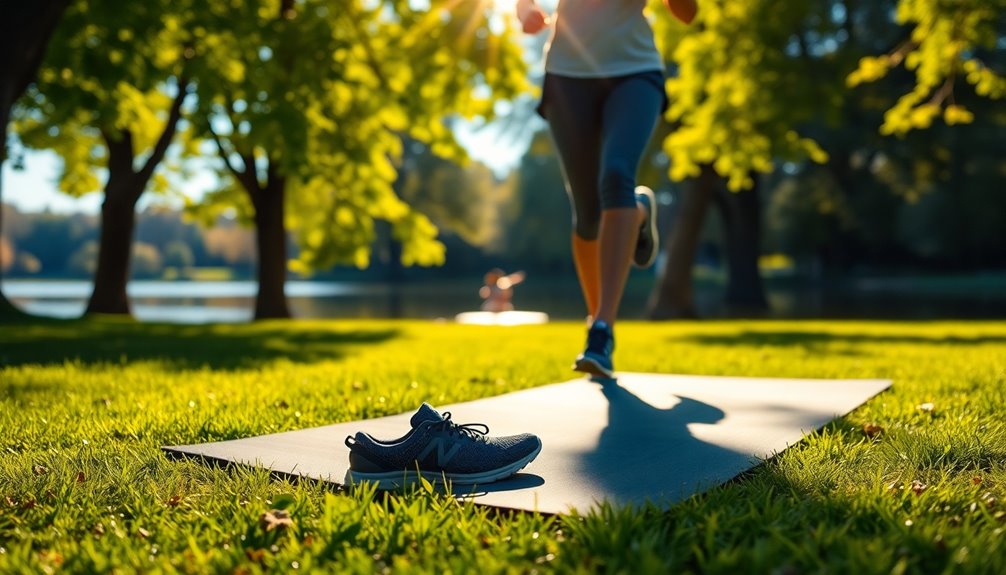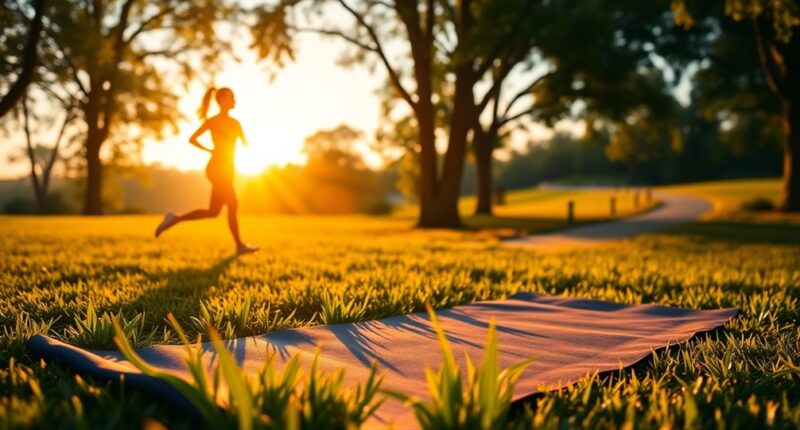Integrating yoga into your running routine can greatly enhance your performance and flexibility while reducing injury risk. Try incorporating short yoga sessions for just 5 to 30 minutes before and after your runs to improve your flexibility and core strength. Focus on specific poses like Warrior and Plank to address muscle imbalances. Make yoga a weekly habit and you'll benefit from better stability and recovery. Discover more about the best types of yoga for runners next.
Key Takeaways
- Incorporate short yoga sessions (5-30 minutes) before and after runs to improve flexibility and reduce muscle tightness.
- Focus on specific poses like Plank and Warrior 2 to address muscle imbalances and enhance strength.
- Attend weekly yoga classes to build core strength and improve overall running form.
- Utilize restorative stretches, such as Child's Pose, post-run to relieve muscle tension and aid recovery.
- Prioritize yoga on running days to allow for adequate recovery and enhance the mind-body connection.
Benefits of Yoga for Runners

When you integrate yoga into your running routine, you release a variety of benefits that can enhance your performance and enjoyment.
Yoga improves flexibility in key areas like your hips and calves, essential for maintaining an efficient stride and preventing injuries. By incorporating yoga poses, you also boost your core strength, helping you maintain proper form and reduce fatigue on long runs.
Additionally, regular practice alleviates muscle imbalances and tightness from repetitive movements, aiding in muscle recovery. Yoga promotes balance and stability, lowering your risk of injury while traversing uneven terrain.
Plus, the mental focus and relaxation gained from yoga enhance your overall running experience, making each run more enjoyable and fulfilling. Additionally, incorporating yoga into your routine can improve flexibility, which may help reduce the risk of injuries associated with running. As you become more attuned to your body, you’ll also start to appreciate the importance of hydration for runners, as staying properly hydrated directly influences performance and recovery. By balancing both yoga and hydration, you can cultivate a holistic approach to your training that promotes not just endurance, but overall well-being.
Types of Yoga for Runners

Yoga offers a variety of styles that cater specifically to the needs of runners, each providing unique benefits to enhance your training. Incorporating yoga can help increase your flexibility and strength, ultimately improving your running performance.
Power Yoga builds endurance and engages core muscles, while Vinyasa yoga connects breath with movement, helping prevent injuries and enhance running form.
Restorative Yoga is perfect for post-run recovery, alleviating muscle soreness through deep relaxation and long-held poses.
Korean Yoga emphasizes breath control, increasing blood flow and mindfulness during your workouts.
Finally, Body & Brain Yoga Tai Chi promotes balance and coordination, essential for maneuvering uneven terrain.
Exploring these types of yoga can greatly elevate your running routine.
Incorporating Yoga Into Your Running Routine

Integrating yoga into your running routine can greatly enhance your overall performance and well-being. Incorporate short yoga sessions ranging from 5 to 30 minutes before and after your runs to help improve flexibility and activate muscles.
Utilize specific poses like Plank and Warrior 2 during warm-ups to address muscle imbalances and prepare your body for running. Attend weekly yoga classes to build strength and enhance your yoga practice, which can boost both physical performance and mental focus.
Post-run, engage in restorative yoga stretches, such as Child's Pose, to relieve muscle tension and promote recovery. To balance your routine, prioritize running on days with yoga, ensuring you allow adequate recovery time between both activities for ideal results.
Key Areas for Yoga Stretches

To enhance your running performance and reduce the risk of injuries, focusing on key areas for yoga stretches is essential. Incorporating yoga into your routine can help runners by targeting crucial muscle groups.
Start with poses like Warrior to strengthen your legs and improve joint mobility. Don't forget to stretch your hamstrings regularly to alleviate lower back pain and boost flexibility.
Focusing on your hip joints enhances stride length, maintaining a natural gait. Incorporate quadriceps stretching for better stamina and circulation, and engage your plantar flexors to prevent strains.
This flow of stretches not only aids in physical balance but also promotes mental clarity, making your yoga routine a powerful complement to your running regimen. Additionally, incorporating diversification strategies in your training can help prevent overuse injuries by varying your workout routine.
Takeaways for Integrating Yoga in Running

Incorporating yoga into your running routine offers numerous benefits that go beyond just flexibility and strength. Practicing yoga helps increase your overall performance by enhancing strength and flexibility in key muscle groups, reducing injury risks.
Attend yoga classes focused on Flow Yoga or Hot Yoga to activate muscles as a warm-up or cool-down, helping balance your body and improving running efficiency. Regular yoga practice strengthens stabilizing muscles, supporting larger muscle groups during runs and minimizing knee and ankle injuries.
Additionally, engaging in restorative poses post-run aids in muscle recovery, alleviating soreness and promoting faster healing. By integrating yoga programs into your routine, you'll foster a stronger mind-body connection, enhancing mental focus and resilience for long-distance training and races.
Frequently Asked Questions
How Do I Incorporate Yoga Into Running?
To incorporate yoga into your running, start by scheduling short sessions before your runs to warm up and activate your muscles.
After running, practice restorative yoga to aid recovery and reduce soreness.
You can also attend weekly yoga classes to build flexibility and strength.
Additionally, integrate yoga movements into your cool-down routine and use non-running days for yoga to target different muscles and enhance your overall performance.
Is Yoga and Running a Good Combination?
Imagine your body as a finely tuned instrument, where yoga and running create a harmonious symphony.
Yes, yoga and running make a fantastic combination! They complement each other beautifully, enhancing flexibility, strength, and mental focus.
By embracing both, you'll reduce injury risks and ease muscle tension, allowing you to recover faster.
Plus, the balance and core strength gained from yoga will elevate your running performance, turning every run into a joyful experience.
Is It OK to Run and Do Yoga on the Same Day?
Yes, it's perfectly okay to run and do yoga on the same day!
Just make sure you prioritize your running session first since it requires more energy and focus.
After your run, a yoga session can help with muscle recovery and flexibility.
Keep your yoga practice gentle if you've got a tough run planned the next day, and allow some recovery time between the two to optimize your performance and prevent fatigue.
Should I Incorporate Yoga Into My Workout Routine?
If you're looking to enhance flexibility, boost strength, and improve recovery, you should definitely incorporate yoga into your workout routine.
It helps you target underutilized muscle groups, improves joint mobility, and promotes better overall body balance.
You'll find that practicing yoga also aids in mental focus and stress reduction, making your workouts more enjoyable.
Plus, using yoga for warm-ups or cool-downs can reduce muscle tightness and soreness, speeding up your recovery time.
Conclusion
Integrating yoga into your running routine can really be a game changer. By enhancing flexibility, balance, and mental focus, you'll find yourself hitting your stride with renewed energy. Don't just run on empty—take the time to stretch and breathe. As you embrace these practices, you'll notice fewer injuries and improved performance. So, lace up those shoes and roll out your mat; you're about to reap the benefits of combining these two powerful activities!









